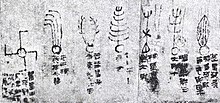The Divination by Astrological and Meteorological Phenomena (Chinese: 天文氣象雜占; pinyin: Tiān Wén Qì Xiàng Zá Zhàn), also known as Book of Silk is an ancient astronomy silk manuscript compiled by Chinese astronomers of the Western Han dynasty (202 BC – 9 AD) and found in the Mawangdui of Changsha, Hunan, China in 1973. It lists 29 comets (referred to as 彗星, huì xīng, literally broom stars) that appeared over a period of about 300 years.

It is now exhibited in the Hunan Provincial Museum.[2]
Contents
editThe Divination by Astrological and Meteorological Phenomena contains what archaeologists claim is the first definitive atlas of comets. There are roughly two dozen renderings of comets, some in fold out/pop-up format. In some cases, the pages of the document roll out to be five feet long. Each comet's picture has a caption which describes an event its appearance corresponded to, such as "the death of the prince", "the coming of the plague", or "the three-year drought."
One of the comets in the manuscript has four tails and resembles a swastika. In their 1985 book Comet, Carl Sagan and Ann Druyan argue that the appearance of a rotating comet with a four-pronged tail as early as 2,000 years BCE could explain why the swastika is found in the cultures of both the Old World and the pre-Columbian Americas.
Bob Kobres, in a 1992 paper, contends that the swastika-like comet on the Han-dynasty manuscript was labelled a "long tailed pheasant star" (dixing) because of its resemblance to a bird's foot or footprint
See also
editReferences
edit- ^ Shu, Ensei; Zhu, Yuanqing (2006). Chūgoku shutsudo bunken no sekai : shinhakken to gakujutsu no rekishi 中国出土文献の世界 : 新発見と学術の歴史 [zh:中国出土文献与伝統学術] [The World of Literature Excavated in China: New Discovery and Academic History] (in Japanese). Translated by Takagi, Satomi. Tōkyō, Japan: Sōbunsha. p. 204. ISBN 978-4-4234-5006-2. OCLC 76918358.
- ^ Hunan Provincial Museum Archived 2016-07-04 at the Wayback Machine
External links
edit